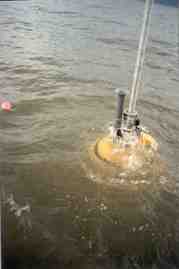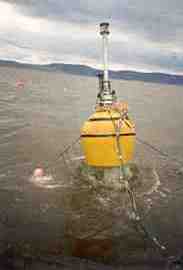|
|
|
The research carried out is aimed at serving as a base for the technical-industrial
development work which still remains before the energy of ocean waves may be utilised for commercial energy supply to a greater extent.
|
|
|

|
|
Wave energy, which is a non-polluting and renewable source of energy, is created by natural conversion of part of the wind energy above the oceans.
Wind energy is created by natural conversion of part of solar energy. By heating air, the sun creates winds.
Winds blowing along the water surface create waves.
|

With both of these energy conversions, the flow of energy is concentrated (as figured in watts per square metre of area).
Just below the ocean's water surface, the wave energy flow, in time-average, is typically five times denser than the wind energy flow 20 m above the sea surface,
and 10 to 30 times denser than the solar energy flow.
Hence, there are good prospects for development of commercial wave-power plants,
which may in the future become significant components for providing energy
to many coastal nations.
|
Historical account of wave-power research at NTH/NTNU.
During more than three decades, since 1973, fundamental wave-power research has been carried out at the physics department of the university in Trondheim (after several reorganisation processes and name changes: at
Department of Physics,
NTNU, [before 1996:
NTH]).
After 2003, wave-energy research has been taken up at other departments of NTNU, i.a. by Centre for Ships and Ocean Structures (CeSOS) and by the Departments
of Civil and Transport Engineering, of Electric Power Engineering,
of Energy and Process Engineering, and of Industrial Economics and Technology Management.
|
In December 1973, university teacher ("førsteamanuens")
Kjell Budal
(1933-1989) initiated wave energy research at the Department of Experimental Physics, Norwegian Insitute of Technology (NTH).
Johannes Falnes participated in the research from the beginning in 1973, and
Per Magne Lillebekken from 1980, until 1998.
Seven persons have completed their doctor degree ("dr.ing." or Ph.D.) thesis,
within wave-power research, at NTH/NTNU, namely: Lars Christian Iversen in 1980, Åge Kyllingstad in 1982, Oddbjørn Malmo in 1984, Geirmund Oltedal in 1985, Arne Brendmo in 1995,
Håvard Eidsmoen in 1996, and Torkel Bjarte-Larsson in 2005.
As post doctors, they had opportunity for working on wave-power research for a certain time (between a few months and three years).
Moreover, about 25 students have completed their wave-energy thesis work for completing the "sivilingeniør" or Master degree in Engineering.
In our activity with construction and laboratory testing of models,
with devolopment of components for wave-power prototypes, and
with technical economic assessments of wave-power plants, we had useful assistance from various departments of
SINTEF
and of NTH, and from various institutions and companies in Norway
(i.a. in Ålesund and in Oslo) and abroad
(i.a. in Trälleborg, Sweden, and in Edinburgh, Scotland).
For the contract work provided by these institutions and companies,
Tormod Hals, a SINTEF employee, served as our project coordinator during years 1979-83,
when he had his dayly office by us at the Department of Experimental Physics.
During the years 1978-82, wave-energy research received substantial financial support from the
Norwegian Ministry of Petroleum and Energy ("Olje- og energidepartementet").
As the price of petroleum declined, and the public interest for problems of environment and resources decreased, during the early 1980s, the governmental financial support of wave-power research was drastically reduced after 1982.
In spite of this fact, the wave-power group in Trondheim has been able to carry on a certain research activity, and maintenance of achieved knowledge and competence.
The group cooperated with industrial companies, i.a. with Kværner Brug AS during eight years from 1975, and with
Lysøysund Industrier AS and
Brødrene Langset AS during a few years in the mid 1980s, and mid 1990s, respectively.
|
|
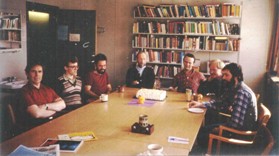
NTH's wave-energy group 1983-03-25.
From left: Kjell Budal, Per Magne Lillebekken, Geirmund Oltedal (Ph.D. student),
Johannes Falnes, Øyvin Sømme (celebrating his completed Master degree
in Engineering Physics, by treating us to a cake), Lars Christian Iversen (postdoctor), Åge Kyllingstad (postdoctor).
[Our collaborator Tormod Hals was not present on this occation.]

|
|
Tormod Hals (left) served, during years 1979-83, as project coordinator for NTH's
project for development of wave-power buoys.
|
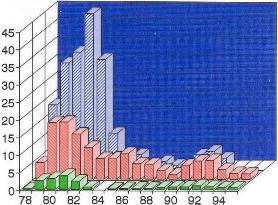
Governmental funding for wave-energy R&D during years 1978-95. Funding amounts, in million NOK, are not inflation corrected.
Back (blue/grey): UK (to 1992, 1 GBP = 10 NOK approximately).
Middle (red): Norway.
Front (green): NTH, Trondheim.
(No significant increase of annual funding in Norway after 1995.)
|
The wave-energy research carried out in Trondheim, in particular during the first ten years after 1973, is of good reputation internationally. This is mainly due to basic theoretical research and, in particular, to proposed methods for optimum control and phase control of wave-energy converters.
[For historical details (for years 1973-2003), in addition to the summary above,
click here.]
|
Wave-power buoys. Model tests
|
During the five to six years when the Norwegian government provided substantial funding for wave-power research and development, the wave energy group at NTH worked on development of power buoys with optimally controlled oscillatory motion
(which is illustrated, e.g., by figures 3 and 4 in the article
"Principles for capture of energy from ocean waves. Phase control and optimum oscillation.")
The creative person Kjell Budal proposed all the three types of power buoys (called "type E", "type M2" and "type N2") that were the group's main consideration. All three types are phase controlled by the latching method.
The type-E buoy has hydraulic power take-off, and an operable valve is used for latching control.
The two latter types (M2 and N2) have pneumatic power take-off, and a latching mechanism or parking brake is used for phase control.
The N2 power buoy is briefly described and assessed in a Norwegian White paper "on new renewable energy sources in Norway" [Stortingsmelding nr. 65 (1981-82), "Om nye fornybare energikilder i Norge"].
More technical details on the N2 buoy may be found in the paper
"The Norwegian wave-power buoy project",
which was presented at The Second International Symposium on Wave Energy Utilization in Trondheim 1982.
More details on all three power-buoy types have later been published in the paper
"Budal's latching-controlled-buoy type wave-power plant,"
which was presented in 2003 at the
Fifth European Wave Energy Conference
in Cork, Ireland.
The information given in this paper is supplemented here with the following illustrative material:
|

Click above on the picture to see it in a larger size.
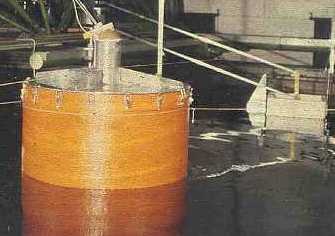
|
|
Click on the small picture (left) in order to see a video clip from this test of a type-E power buoy model.
[If the video file, a
WMV file, is not being opened, try to open it
here in MOV-format version.]
|
|
|
Left:
Photo from testing of the power-buoy model of type E in NTH's ship model tank 1978.
Kjell Budal is seen on the movable bridge that spans the approx. 10 m wide model tank.
Beside him, there is a power-delivery device that contains a pair of gas accumulators, which serves as a short-time energy storage.
It is supplied with energy through a hydraulic hose, which is connected to the 1.1-m-diameter buoy hull, which contains a hydraulic system with a piston pump, an operable valve for phase control, and another gas accumulator that provides pre-tension in the steel cable that connects the pump piston to an anchor on the bottom of the tank, nearly 6 m below the water surface.
The white float, in the right part of the picture, contains a wave-measuring accelerometer.
|

|
|
Left:
Photo from testing of the power-buoy model of type M2 in NTH's ship model tank 1980.
The conical buoy hull has a maximum diameter of 0.9 m.
Between circumferential markers there is a vertical distance of 0.5 m.
The buoy model contains a piston pump with piston rod that extends down to a universal joint on an anchor on the bottom of the tank.
The white float, seen on the left side of the buoy, contains a wave-measuring accelerometer.
Click on the picture in order to see a video clip from this test of a type-M2 power buoy model.
[If the video file, a
WMV file, is not being opened, try to open it
here in MOV-format version.]
|
A power-buoy model of type N2 was tested 1981 in NTH's ship model tank. Its hull, of diameter 1 m, had a closely spherical hull, constructed in plexiglass.
Subsequently, the hull was covered by glass-fibre reinforced plastic, before the model was tested in the Trondheim Fjord.
Altogether it was sea tested during 170 days, spread over six periods during 1981 to 1983.
In order to reduce viscous energy loss, the hull was rebuilt between the fifth and sixth testing periods.
Below:
Photo from sea testing of an N2-type wave-power buoy in the Trondheim Fjord 1983.
The diameter of the model buoy is 1 m.
The floating buoy can oscillate along a strut that, at its lower end, is connected to a universal joint on an anchor on the sea bed.
The water depth, which depends on the tide, is in the range of 4 to 7 m.
On the top of the hull, the latching mechanism and one of the guiding-roller units are visible.
As the bottom of the hull is open, sea water is flowing into, and out from, an inner chamber, where the water surface acts as the piston of an air pump.
The three photos show, from left to right, first, the buoy when moving near its equilibrium position, then, when latched in low position, and finally, when latched in upper position, at an occasion when a surprisingly deep wave trough appeared.
|
|
Click on the left photo in order to see a video clip from the test with the N2-power-buoy model in the Trondheim Fjord 1983.
[If the video file, a
WMV file, is not being opened, try to open it
here in MOV-format version.]
|
Teaching on wave energy - at the physics department.
|
Wave energy is one of several subjects contained in the course Physics and Energy, which was taught also at the Norwegian Institute of Technology (NTH), University of Trondheim, every year since 1974, when Jørgen Løvseth initiated the course Energy and Environmental Physics (with essentially the same content), at the College of Arts and Science (AVH), University of Trondheim. After 2000, when the two university physics departments moved together into the new Science Building of NTNU, the two courses were combined into one course, Energy and Environmental Physics.
In 1979, Johannes Falnes started teaching a more advanced and theoretical course,
Ocean Wave Energy. Until 2001, this "dr.ing." course has been taught every second year, except in 1983.
[For more details about teaching on wave energy,
click here.]
|
Reports and publications.
|
A separate list names the authors and titles of
scientific
papers, reports and other publications
from the wave energy group at NTNU.
Moreover, the following papers/reports/notes
listed below, were 1997/98, in full version, placed on Internet.
Moreover, some additional
previous reports and notes,
in scanned version, have now been placed on the web.
Internet-submitted reports:
J. Falnes:
"Energi frå havbølgjer før, no og sidan."
This (1996) note in Norwegian contains a historic review of wave power research,
including a view towards the future. The note, which includes
two figures, is aimed at non-specialist readers.
A revised version of the note has been published as a paper in the Norwegian journal Elektro, Volume 110, No. 6, 1997, pp. 58-64.
J. Falnes: "Principles for capture of energy from ocean waves. Phase control and optimum oscillation."
By referring to illustrations (six figures), but without using mathematics, this (1997) note
explains the principle for absorption of wave energy by means of an oscillating system. It also explains how the system should oscillate in order to absorb as much energy as possible.
During more than twenty years, these principles have directed much of the wave-energy research carried out at the university in Trondheim. The note, which includes 15 literature references, is aimed at non-specialist readers.
J. Falnes:
"Prinsipp for opptak av energi frå havbølgjer. Fasestyring og optimal svingerørsle."
Norwegian version of the same (1997) note.
A revised version of this note has been published as a paper in the Norwegian journal Elektro, Volume 111, No. 1, 1998, pp. 102-106.
J. Falnes:
"Optimum control of oscillation of wave-energy converters" .
Paper no. 2 in Annex Report B1 to the JOULE project "Wave Energy Converters: Generic Technical Evaluation Study". Contract no. JOU2-0003-DK between the Commission of European Communities and Danish Wave Power aps. August 1993.
Since this publication is distributed in rather few copies, we have placed the paper on Internet.
The paper, which presents a review of the research carried out during the twenty years after 1973 on optimum control of wave-power devices in order to maximise the power output, is aimed at specialist readers, although only a minimum of mathematics is used.
The note does not include any illustrations, but 39 references.
[Later this report has been extended, and, in 2002,published as a journal paper
(see entry # 48 in the listing of our publications).]
H. Eidsmoen:
"Simulation of a tight-moored amplitude-limited heaving-buoy wave energy converter with phase control".
This rather long (1996) paper, which includes 12 figures, 7 tables, 28 references and 18 numbered and displayed mathematical formulae, is aimed at specialist readers.
The paper represents an extension and enlargement of the following published work:
Eidsmoen, H.: "Simulation of a heaving-buoy wave energy converter with phase control".
Proceedings of the Second European Wave Power Conference,
(edited by Elliot, G. and Diamantaras, K.) Lisbon, Portugal, 8-10 November, 1995,
European Commission ECSC-EC-EAEC, Brussels, pp 281-288, 1996. (ISBN 92-827-7492-9).
A summary of this paper has been printed in Applied Ocean Research, Vol. 20, No. 3, 1998, pp. 157-161.
H. Eidsmoen:
"Simulation of a slack-moored heaving-buoy wave energy converter with phase control".
This rather long (1996) paper, which includes 10 figures, 13 tables, 34 references and 19 numbered and displayed mathematical formulae, is aimed at specialist readers.
|
|
| |
|










